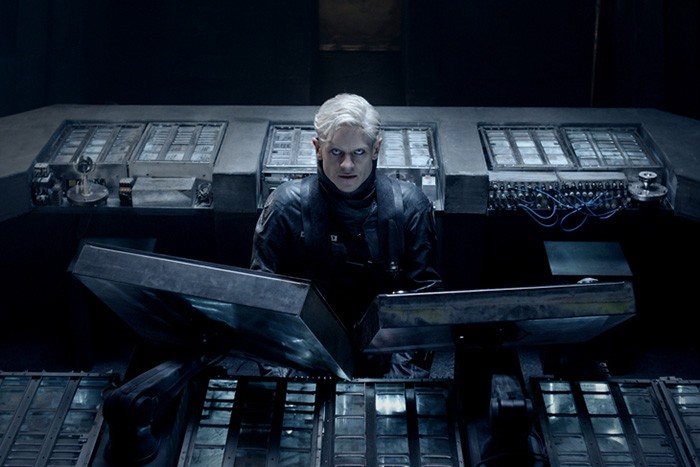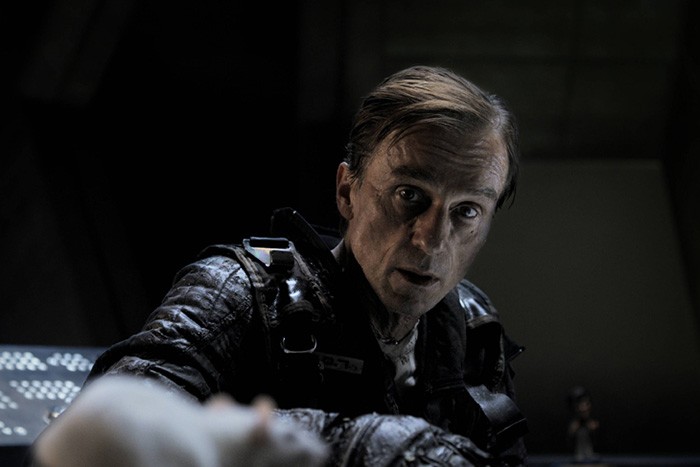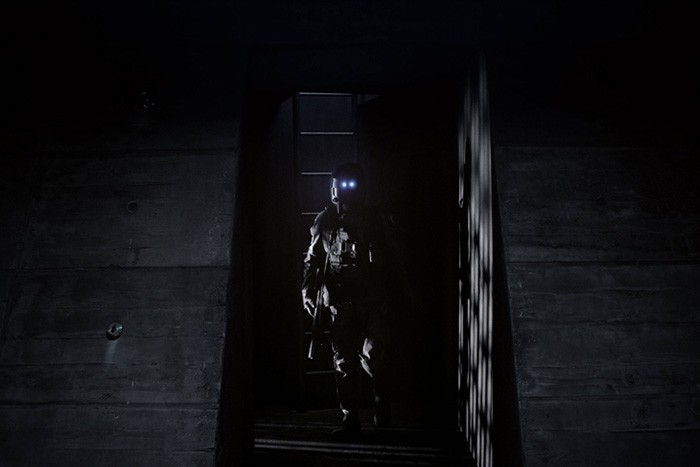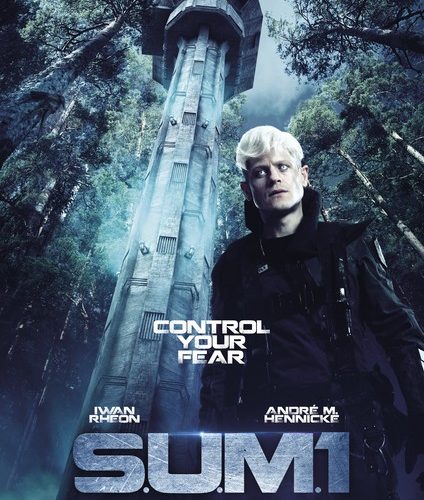It’s been decades since a new world order changed Earth forever, an alien invasion by creatures known as the Nonesuch forcing humanity underground. The old guard who survived remembers the war that drove them subterranean, memories of life on the surface and the beasts that present-day generations hope to never encounter. If any of them do want to risk their lives for a glimpse of the sun they’ve only heard about through stories, though, they can enlist in the military and become a soldier tasked with a one hundred day mission meant to find stragglers and point them towards sanctuary: Exilium. Battles still rage, but humanity has all but resigned itself to its defeat. Now it’s a matter of staying alive to save those who were left behind.
This is the background to Christian Pasquariello’s debut feature S.U.M.1 — a high concept, low budget one-man science fiction show. Said man (Iwan Rheon) is known by the title’s serial number, names erased from human consciousness as a worthwhile concept. Families exist with parents and children and love, but it makes more sense to catalog rather than individualize when there are so few left and everyone lives for a common goal. He embraces this notion, joining the cause to do his part and protect outpost Cerberus along with any human refugees lost in the forest without direction or hope. Outfitted with a sun-blocking helmet due to eyes evolved in darkness, S.U.M.1 (yes, “someone” as in “anyone” as in “us”) arrives to replace his predecessor. Only his predecessor isn’t there.

And so begins a series of twenty-four hour periods marred by monotony and repetition. The computer wakes him in the morning before doing sit-ups on the balcony, monitoring the surveillance cameras watching his base’s perimeter, checking in with a disembodied voice (Tim Williams) back in Exilium to learn the ever-changing security code, eating a non-descript paste of nutrients, and smoking his single government-issued cigarette labeled by the day’s number in countdown from one hundred to one. Sometimes he exits the concrete tower to search the surrounding area (he isn’t allowed to travel past his own border) for animals or survivors, always wearing sunglasses until his vision has adapted to the sun. It’s a lesson in futility, but backed by purpose. He serves as a necessary line of defense.
Amidst the boredom, however, are questions. What happened to the man he was supposed to replace, V.A.X.7 (Rainer Werner)? Why is there what appears to be a bloodstain on the wall of his quarters? How did a benevolent white mouse come to reside within Cerberus? And whom could V.A.X.7 have been talking to on a walkie-talkie S.U.M.1 finds in his locker? Home has told him that his predecessor had to be evacuated early due to health concerns, but would they have left his dog tags and belongings behind? Perhaps a Nonesuch penetrated the defenses and killed him. Maybe V.A.X.7 went insane and shot himself. When there’s literally nothing to do but stare at computer screens, excitement must be created elsewhere. For S.U.M.1, conspiracy theories become his go-to entertainment.

It’s therefore Pasquariello’s job to ratchet up the sense of claustrophobia for his character’s sake and ours. Mysterious figures begin sliding out from amongst the trees. Shadows start to present like monsters, their similarities to the Nonesuch remaining an unknown quantity since S.U.M.1 doesn’t know what they look like. Control seeks to calm him down and relay that nothing can enter his perimeter without tripping alarms, but the first instance of power failure renders such assurances half-hearted. Tensions rise, the voice of a neighboring base is heard (Norman Reedus as K.E.R.4), and tech-support is sent for in the form of Mac (André Hennicke) despite being delayed due to devastating attacks very close by. The more S.U.M.1 becomes isolated from the outside world, the more we question his sanity.
Suddenly the fact that Christian Alvart serves as producer makes sense, his own psychological horror Pandorum possessing many of the same stripped down themes with a moderately more robust budget for effects (an estimated one million dollar price-tag for Pasquariello against thirty-three million for Alvart). The set is a formidably dystopian concrete structure and the wardrobe futuristic yet practical, but the infusion of toxic gas can’t help feeling inauthentic. A climactic battle scene doesn’t look too bad due to it taking place at night, but you still wonder what might have been with extra money to let the aesthetic truly pop. Luckily Rheon is up to the task of compensating for these shortcomings with the type of off-kilter performance he’s known for (see Misfits and Game of Thrones).

It’s hard not to assume every character Rheon plays is sociopathic or insane because he does both so well. Add the crippling confinement of his circumstances and the bond formed with his pet mouse Doc and the idea he’s cracking under pressure is ever-present. What’s interesting, however, is that Pasquariello hints at truth itself being under question rather than just S.U.M.1 himself. We assume V.A.X.7 lost his marbles and S.U.M.1 is following suit (maybe the mouse is infected with something or this length of time without human contact is simply too much to bear), but what if their paranoia is founded? What if the ruling class fabricated the Nonesuch for control, these missions merely ruses to retain it? Something is happening here. But how far does it go?
Pasquariello does a great job keeping us on our toes as far as motivation and ambition because so much happening could be taken multiple ways. Suddenly we become uncertain as to what’s reality and what’s not—S.U.M.1 does dream after all, something humans haven’t done for decades. He questions everything out of fear and isolation; we question him because he cannot be trusted. To suddenly shift from an hour watching one person on-screen to a half hour of strangers, voices, and monsters means we must wonder what’s been/is a fabrication if anything was/is at all. And despite some effects compromising our belief in this world, Rheon holds our attention enough to pity him, empathize with him, and ultimately fear for his safety. It’s not paranoia if it’s real.
S.U.M.1 screened at the Fantasia International Film Festival and opens on December 1.

